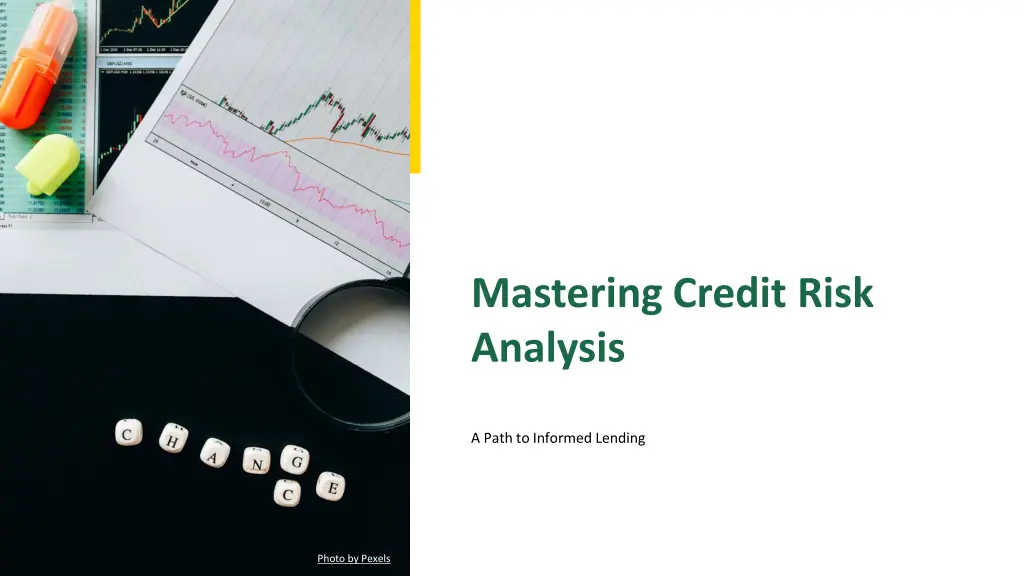
Path to Informed Lending: Understanding Credit Risk Analysis
Discover the importance of credit risk analysis in informed lending decisions. Explore topics such as the role of financial institutions, the impact of machine learning, real-world case studies, and the purpose of credit risk analysis in mitigating financial losses.
Download Presentation

Please find below an Image/Link to download the presentation.
The content on the website is provided AS IS for your information and personal use only. It may not be sold, licensed, or shared on other websites without obtaining consent from the author. If you encounter any issues during the download, it is possible that the publisher has removed the file from their server.
You are allowed to download the files provided on this website for personal or commercial use, subject to the condition that they are used lawfully. All files are the property of their respective owners.
The content on the website is provided AS IS for your information and personal use only. It may not be sold, licensed, or shared on other websites without obtaining consent from the author.
E N D
Presentation Transcript
Mastering Credit Risk Analysis A Path to Informed Lending Photo by Pexels
01 Understanding Credit Risk Table of Contents 02 The Role of Financial Institutions 03 Importance of Machine Learning 04 Case Study: Indonesian Financial Organization 05 The Purpose of Credit Risk Analysis 06 The 5 Cs of Credit 07 Qualitative vs Quantitative Measures 08 The Risk Mitigation Strategy 09 Future of Credit Risk Analysis 10 Thank You for Your Attention
1 Understanding Credit Risk What is Credit Risk? Credit risk is the potential for financial loss due to a borrower's failure to make necessary payments. Such failures result in losses for lenders, impacting both principalamounts and interest. Understanding this risk is crucial for financial institutions providing loans to customers. Effective analysis can help mitigate these risks and protect customer interests. Photo by Pexels
2 The Role of Financial Institutions Why Analyze Credit Risk? Financial institutions need to prevent significant losses from defaultingcustomers. An effective credit risk analysis enables informed lending decisions. This analysis helps in recognizing reliable borrowers and minimizing potentialthreats. It fosters a healthy financial environment for both lenders and borrowers. Photo by Pexels
3 Importance of Machine Learning Automation in Risk Analysis Machine Learning simplifies the credit risk analysis process, making it efficient. It reduces human error and eliminates biases in decision- making. Automated analysis provides accurate predictions about potential risk factors. This technology is a game changer for financial institutions. Photo by Pexels
4 Case Study: Indonesian Financial Organization Real-World Application A PoC was conducted to analyze credit risk in an Indonesian lending institution. Customer data was analyzed to predict potential defaultrisks. This case exemplifies the practical use of credit risk analysis in lending decisions. It shows the value of proactive risk management strategies. Photo by Pexels
5 The Purpose of Credit Risk Analysis Cushioning Against Losses Credit risk analysis helps lenders assess borrowers' ability to meet obligations. It protects lenders from loss of cash flow and severe financial impacts. Determining credit risk influences interest rates charged to borrowers. Higher risks equate to higher interest, ensuring lenders are compensated. Photo by Pexels
6 The 5 Cs of Credit Key Evaluative Factors Credit analysis revolves around the 5 Cs: Capacity, Character, Capital, Conditions, and Collateral. These factors are critical in evaluating a borrower s creditworthiness. Lenders analyze these aspects to estimate default probabilities accurately. These measures provide a holistic view of the borrower s financial health. Photo by Pexels
7 Qualitative vs Quantitative Measures A Balanced Assessment The 5 Cs incorporate both qualitative and quantitative financial assessments. Qualitative insights help evaluate borrower character and conditions. Quantitative data includes statements, balance sheets, and credit reports. This balanced approach enhances the credit evaluation process. Photo by Pexels
8 The Risk Mitigation Strategy Protecting Financial Institutions Credit risk analysis allows lenders to identify at-risk borrowers early. By predicting risks, lenders can avoid granting loans to unreliable customers. This strategy minimizes losses and enhances overall financial stability. Risk mitigation is essential for sustainable lendingpractices. Photo by Pexels
9 Future of Credit Risk Analysis Embracing Innovation The landscape of credit risk analysis is evolving with technology advancements. Continuous improvements in algorithms and data analysis techniques enhance accuracy. Financial institutions must adapt to these changes to stay competitive. The future holds promising developments in risk assessment methodologies. Photo by Pexels
10 Thank You for Your Attention Questions? Let's Discuss! We appreciate your interest in understanding credit risk analysis better. Please feel free to ask questions or share your insights. Together, we can enhance financial decision-making processes. Thank you for being a part of this presentation. Photo by Pexels
